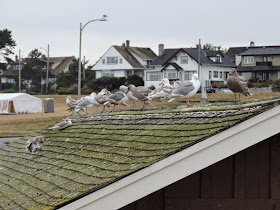But we did see some neat geology, and discovered a pretty good site for studying the regional rocks.
 |
| Photo by Mrs. Geotripper |
 |
| Photo by Mrs. Geotripper |
Goldstream Provincial Park turns out to have a lot of important geology in only 800 or so acres! The Leech River Fault, a major terrane boundary, cuts through the park. It hosts a surprising variety of plant and animal life, due to a wide variety of habitats. Part of the value of the park is that it has not been logged, and thus preserves old-growth forests, including 700 year old Cedar trees.
The main park trail winds past some of the finest examples of old trees.
The appearance of a rainforest belies the fact that the park includes one of the northernmost examples of a dry Mediterranean climate zone on the continent, and maybe in the world. Such climates are distinguished by dry summers and mild winters. The mild climate results from the moderating effects of the Pacific Ocean and Strait of Georgia, and the dryness from the rainshadow effect of the mountains along the main part of Vancouver Island.
The park includes an estuary complex and river (the Finlayson Arm) that hosts ten different species of fish, including three salmon species, Steelhead trout, and Coastal Cutthroat Trout. The estuary is evidence of the glacial origin of this landscape, having been carved by the continental glaciers that covered the region as recently as 13,000 years ago. The glaciers were exploiting a weakness in the rocks from a fault that ran through the valley.
Looking south from the Nature Center one can see Mount Finlayson, another feature that indicates the presence one time of glaciers. The rounded form of the mountain identifies it as a roche moutonnée, a larger-scale version of the rounded forms seen in Beacon Hill Park in Victoria. The rocks making up the peak are metamorphic volcanic rocks and granitic plutons dating from the Mesozoic Era.
One might wonder the derivation of the name of the park. The rocks on the west side of the canyon are part of the Leech River Complex, a collection of schist and slate dating from the late Mesozoic Era. The rocks at one time or another were altered by superheated mineralized water, and quartz veins with minor amounts of gold were emplaced in the area. The gold was discovered in 1858, and a minor rush involving perhaps 300 miners ensued a few years later. There was not a great deal of gold to be had, and the boom soon petered out, but the name remained. A few old tunnels and mines can still be seen in the park.
There was one more treasure for us to discover. When the ice sheet moved through the area, it preferentially eroded the north-south fault valley, and the east-west drainages were not cut so deeply. When the ice disappeared, the side drainages remained as elevated river valleys, and waterfalls were formed. A beautiful small waterfall with the somewhat pretentious name Niagara Falls can be reached by a short hike from the parking area. The name comes clearly not from the volume of the waterfall, but from the height, which at 155 feet (47.5 meters), is similar to that of its more famous cousin in New York/Canada (167 feet/51 meters).
We were there in the dry season (despite the rain that was falling on us), and the falls were at such a low ebb that the pool at the base was not flowing more than a few meters downstream. It was sinking underground instead.
Goldstream Provincial Park was a fascinating little park to visit, but by then our schedule was in serious trouble. We had to catch a 5:30 pm ferry in Nanaimo, and it was well past lunchtime (but we had not had lunch). We hit the highway and headed towards Duncan for food. And some really cool anthropology, as it turned out.










This looks like it turned out alright. Good to have a plan C, D, E...
ReplyDelete